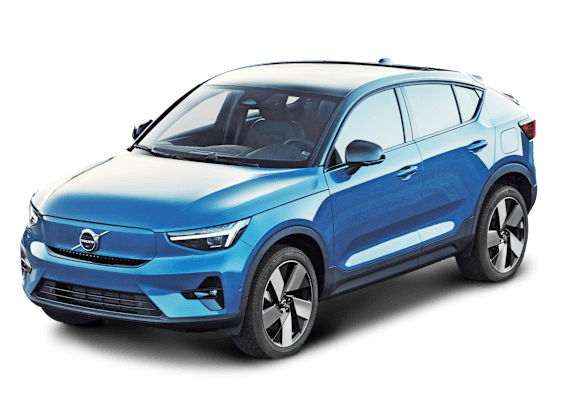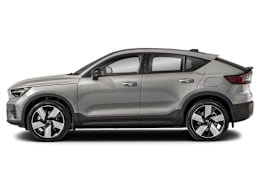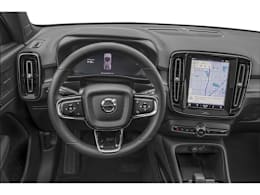The C40 Recharge is a fully-electric small SUV that combines the ride height of an SUV with the more limited cargo space of a hatchback car—a concession for its swoopy styling.
The 402-horsepower, twin-motor Ultimate all-wheel-drive version we tested is exceptionally quick and proved to be a pretty sharp handler on a twisty road. We found the front seats comfortable and the cabin looks and feels well put together. Unfortunately, the ride is stiff and Volvo’s controls are frustrating and unintuitive to use. And while EVs are typically among the quietest vehicles on the road, the C40 Recharge’s cabin gets filled with an abundance of wind noise at highway speeds. It also suffers from extremely compromised rearward views, thanks to super-thick rear roof pillars and a slit-like back window.
Also not helping the C40’s case is that it has a slightly higher starting price than the more versatile all-electric XC40 Recharge that it’s based on.
We bought a 2024 Volvo C40 Recharge Twin Motor Ultimate for $62,340—anonymously from an area dealer, as we do with every vehicle we test—for the purpose of this road test review. The C40 Recharge is assembled in Belgium, and utilizes a rear motor that’s built in Sweden and a front motor built in China.
Driving experience
As with most EVs, the C40 accelerates quickly and effortlessly, thanks to an abundance of power that’s instantly available with a dab of the accelerator pedal. Its dual electric motors, which together churn out 402 hp, enabled the Ultimate version we tested (which is the top C40 Recharge trim level) to blast from 0 to 60 mph in a scant 4.4 seconds—a time that puts many conventionally-powered sports cars to shame.
However, we didn’t love the C40’s regenerative-braking system, which slows the vehicle when coasting while recouping energy that gets sent back to the battery. First, the C40’s regen levels aren’t as adjustable as in many EVs; the system is either “Off,” “On” (which is a very aggressively-decelerating “one-pedal driving” mode that allows you to control the car’s speed and braking purely with the accelerator pedal), or it can be put into an “Auto” mode.
Because the C40 slows with such force as soon as you start releasing pressure on the accelerator pedal when it’s set to “On,” we found that it took extra effort to drive the car smoothly so as to not make passengers nauseous. But when you do remember that you’re in that mode, we found it pretty easy to time things so that you can come to a stop exactly where you wanted without having to step on the actual brake pedal. The “Auto” mode didn’t prove to be a great solution, either. It didn’t always make sense when or why it would—or wouldn’t—slow down for cars ahead of you.
Driving range is of utmost importance in an EV, and here the C40 Recharge literally comes up a bit short. The twin-motor model we tested has a 78-kilowatt-hour battery that the EPA rates at 257 miles of driving range. But it only managed 232 miles during our 70-mph highway-range test. At least the battery can be recharged relatively quickly, capable of gaining about 34 miles of range on a Level 2, 240-volt home-charging system. The C40 has a maximum acceptance rate of 150 kW at public DC fast chargers, which is okay but far from class-leading. Volvo also makes a single-motor, rear-wheel-drive version of the C40 Recharge that produces 248 hp and has an EPA-estimated 297-mile driving range.
We found the C40 Recharge surefooted through corners, and our drivers appreciated the balance and control that comes from its rear-drive-biased all-wheel-drive system when upping the ante on a fun, twisty road. But it’s not as agile as its small size would suggest; it feels heavy, body roll increases quickly when pushing the pace, and the steering—while nicely weighted—lacks sufficient feedback to the driver. Still, it performed well through our avoidance-maneuver test, and it exhibited short panic-brake stopping distances.
As with most Volvos of late, the C40’s ride is stiff and it even feels tense at times on the highway. Road imperfections that are barely noticeable in most cars punch through into the cabin in a pronounced way. And while EVs are inherently quieter than most vehicles on the road due to the absence of a gasoline-powered engine, the C40 suffers from elevated wind noise on the highway, in part thanks to its large, fixed-glass roof.
Cabin comfort
The cabin is either drab or minimalist, depending on your viewpoint. While it’s certainly not flashy, it does have some interesting textures here and there and overall the build quality is decent. We found the front seats to be comfortable and supportive—not a surprise, as this has traditionally been a Volvo strong suit. There’s plenty of headroom up front, but the plastic center console hems in the driver’s right knee, the door- and center armrests are on different planes, and several drivers found that the steering wheel blocked off some information at the top of the instrument screen.
Outward visibility is heavily compromised to the rear of the C40 due to the swoopy styling. It has very thick rear roof pillars along with a tiny back window, and it feels like you’re in a cave in the cramped rear seat. Headroom will be tight back there for most adults, and the seatback is at an uncomfortably upright angle—it can’t be reclined, unlike in many SUVs. The one bright spot is that there’s plenty of foot space underneath the front seats.
Controls and usability
As has been typical of Volvos lately, the controls inside the C40 are unintuitive. Many tasks require a multi-step sequence to perform, whether it’s changing a radio station, switching the audio source, or setting cabin temperature. It doesn’t help that the 9-inch touchscreen is small by today’s standards, and it’s surprising that the C40 doesn’t have wireless Android Auto or Apple CarPlay capability. Adding to the confusion are poorly labeled steering wheel controls that have more than one function.
Active safety & driver assistance
Standard active safety and driver assistance features include automatic emergency braking with pedestrian, cyclist, and large animal detection, as well as automatic emergency braking that operates at highway speeds, blind spot warning, rear cross traffic warning, reverse automatic emergency braking, lane departure warning, lane keeping assistance, and automatic high beams. Unfortunately, adaptive cruise control and lane centering assistance only come on the top trim line.
A rear occupant alert system comes standard, which is designed to remind the driver—based on rear-door logic—to check the rear seat when the C40 Recharge is put into Park to help prevent children and pets from suffering heatstroke or hypothermia if unintentionally left behind in the vehicle. The C40 also has a standard rear belt minder, which alerts the driver if a rear passenger unbuckles their seat belt during the trip.























